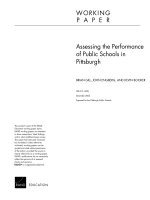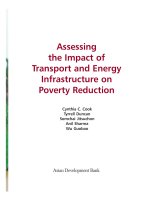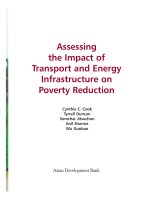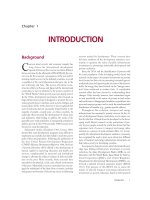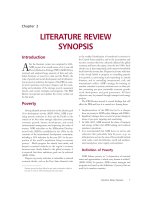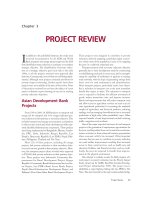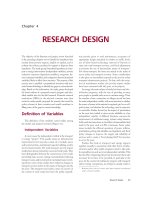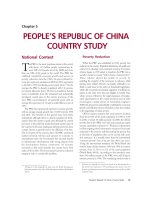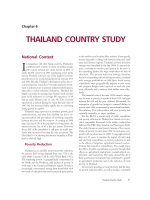ASSESSING the ACCURACY of REMOTELY SENSED DATA - CHAPTER 8 (end) ppt
Bạn đang xem bản rút gọn của tài liệu. Xem và tải ngay bản đầy đủ của tài liệu tại đây (1.3 MB, 46 trang )
©1999 by CRC Press
CHAPTER
8
The California Hardwood Rangeland
Monitoring Project
INTRODUCTION
This chapter provides a detailed, real-world example of using the principles and
practices outlined in this book to assess the accuracy of maps produced from both
photo interpretation and the classification of digital satellite imagery. This specific
case study was chosen for two reasons:
1. The assessment included analysis of the accuracy of maps created from both photo
interpretation and satellite image classification, allowing for comparison of both
mapping and accuracy assessment methods.
2. Numerous trade-offs between statistical rigor and practical implementation were
required throughout the project.
As you will see, this case study is far from being the perfect example of accuracy
assessment design, implementation, and analysis. The project was one of the first
production accuracy assessments performed and, as such, offered ample opportuni-
ties for learning. Yet it is illustrative of problems typically encountered in accuracy
assessment. The case study presents a real-world example with real world trade-offs
and considerations. The implications of each decision are analyzed and discussed.
The purpose of the case study is to make the reader fully aware of both the obvious
and the subtle, yet critical considerations in designing and implementing an accuracy
assessment.
BACKGROUND
Low use and low value have traditionally characterized California’s hardwood
rangeland resource. However, over the last 40 years increasing populations have
forced development into hardwood rangelands, focusing new demands on hardwood
L986ch08.fm Page 85 Monday, May 21, 2001 1:16 PM
©1999 by CRC Press
lands, and resulting in changes in the extent and distribution of this resource.
Hardwood stocking has declined, as has the number of acres of hardwoods with the
conversion to industrial, residential, and intensive agricultural uses.
To assess and analyze the nature and implications of these changes, the California
Department of Forestry and Fire Protection (CDF) instituted long-term monitoring
of the hardwood resource as part of the Integrated Hardwood Range Management
Program. In the late 1980s, the California Department of Forestry and Fire Protection
contracted with the California Polytechnic Institute at San Luis Obispo to complete
a map of the hardwood cover types in areas less than 5,000 feet in elevation within
the State of California. This area is known as the hardwood rangeland zone. This
photo-based map was derived from photo interpretation of 1981 aerial photography
and portrays the type and extent of hardwood rangelands throughout the state
(Pillsbury et al. 1991).
In late 1990, the CDF contracted with Pacific Meridian Resources to create
a new map from satellite imagery and to assess the accuracy of both the new
map and the photo-based map. This chapter concentrates on the methods, assump-
tions, and results of the accuracy assessment portions of the project. The sample
design, data collection, and analysis methods used to assess the accuracy of both
the photo and satellite derived maps are presented. Analysis results are discussed
as well as the practical trade-offs apparent in each accuracy assessment task.
Additional information of the methods used to create the maps can be found in
California Hardwood Rangeland Monitoring: Final Report (Pacific Meridian
Resources 1994).
The accuracies of four maps were assessed:
• Tree crown closure created from photo interpretation of 1981 aerial photography;
• Land cover type created from photo interpretation of 1981 aerial photography;
• Tree crown closure created from classification of 1990 digital satellite imagery;
• Land cover type created from classification of 1990 digital satellite imagery.
The organization of this chapter follows the organization of Chapters 3, 4, 5,
and 6. First, the project’s sample design is discussed. Next, data collection and
methods are presented. Finally, the results of the accuracy analysis are detailed.
SAMPLE DESIGN
Sample design is critical to any accuracy assessment. The sample design for
this project was extremely complex because it involved the assessment of four
different maps (the 1981 photo and 1990 satellite maps) and used two types of
reference data (the 1981 photos and field visits accomplished in 1991). As a result,
trade-offs between statistical rigor and practicality are apparent throughout this
case study. In particular, budget considerations directed the choice of source data.
Because the state could not afford to fly new photography, existing aerial photog-
raphy from 1981 was used as the primary source data for assessment of both the
L986ch08.fm Page 86 Wednesday, May 16, 2001 1:33 PM
©1999 by CRC Press
1981 and 1990 maps. Use of the 1981 photos, in turn, drove much of the sample
design, including the selection of the appropriate sample unit and the methods used
to select the sample units.
Sample design for this project addressed three types of samples:
1. Samples from the 1981 map polygons for photo interpretation and assessment of
both the 1981 photo and 1990 satellite maps.
2. Samples from the 1981 map polygons for field data collection and assessment of
the 1981 photo-based map, the 1990 satellite-based map, and the 1992 photo
interpretation of the 1981 photos.
3. Sample areas classified as hardwoods in the 1990 satellite-based map that fell
outside of the extent of the 1981 photo-based map, to assess the accuracy of the
extent of the 1981 map.
As with all accuracy assessments, sample design involved addressing the ques-
tions posed at the beginning of Chapter 3:
1. How is the map information distributed?
2. What is the appropriate sample unit?
3. How many samples should be taken?
4. How should the samples be chosen?
How Is the Map Information Distributed?
The study area is the hardwood rangeland of California, which forms a donut-
shaped area around California’s Central Valley, and is depicted in Figure 8-1. Almost
all of California’s hardwood tree and shrub species occur in the area. This project
concentrates on the hardwood tree ecosystems.
The extent of the 1981 coverage was defined as areas where hardwood cover
types occur in California below 5,000 feet in elevation. The extent of the 1990
coverage was initially defined to be that of the 1981 maps. However, while the 1990
maps were being produced, errors of omission were discovered in the 1981 maps.
Accordingly, the extent of the 1990 maps was greatly expanded to include over
30 million acres of land. To assess possible errors of omission, accuracy assessment
samples were taken in locations mapped as hardwoods on the 1990 map but omitted
from the 1981 hardwood map.
The classification schemes for this project characterize California’s hardwood
rangelands by tree crown closure and land cover type (including hardwood cover
types). Tree crown closure was classified into the following five classes:
1. 0% (non-hardwood)
2. 1–9%
3. 10–33%
4. 34–75%
5. 76–100%
L986ch08.fm Page 87 Wednesday, May 16, 2001 1:33 PM
©1999 by CRC Press
The land cover classification system consists of 12 classes:
1. Blue oak woodland
2. Blue oak/gray pine woodland*
3. Valley oak woodland
Figure 8-1 Map of the study area.
* Referred to as blue oak/digger pine woodland in the 1981 photo-based map. Digger pine is now called
gray pine.
L986ch08.fm Page 88 Wednesday, May 16, 2001 1:33 PM
©1999 by CRC Press
4. Coastal oak woodland
5. Montane hardwood
6. Potential hardwood
7. Conifer
8. Shrub
9. Grass
10. Urban
11. Water
12. Other
Figure 8-2 is a dichotomous key that illustrates the rules used to distinguish
between land-cover type classes.
Like most land cover types, spatial autocorrelation exists in hardwood rangeland
types. For example, California’s annual summer drought results in hardwoods often
being distributed in canyons and on northeast-facing slopes, where water stress is
less than other areas.
What Is the Appropriate Sample Unit?
The preliminary accuracy assessment sampling design anticipated that the veg-
etation type polygons developed for the 1981 hardwood coverage could be used as
the sampling units for accuracy assessment of both the 1981 and the 1990 maps.
Unfortunately, use of this coverage as a source of sample units created multiple
practical issues.
• First, using the 1981 polygons as the accuracy assessment sample units assumes
that the polygons are homogeneous by crown closure and land cover type class,
accurately delineated, and free of errors of omission. However, during the course
of the project, significant errors of omission and polygon delineation were discov-
ered in the existing maps. As a result many of the 1981 polygons had more class
variation within the polygons than existed between the polygons. Many of the
polygons exhibited (1) such highly variable crown closure and/or cover types that
individual polygons actually consisted of two or more different crown closure
classes and/or cover types and (2) arbitrary polygon boundaries through homoge-
neous vegetation types.
• Second, the existing polygon map also appeared to have been digitized at a much
smaller scale than the photography, resulting in many straight edges that often
extended beyond vegetation type rather than following the actual boundaries.
• Finally, many of the accuracy assessment polygons were several hundred acres in
size, crossing several aerial photographs. Their large size made them impractical
to photo interpret or to traverse in the field.
The following steps were taken to address these problems:
1. When the sample polygon contained multiple classes or was poorly delineated, a
new homogeneous sample polygon was delineated within the original polygon. A
box was delineated on the 1981 stereo photography within each randomly selected
sample polygon. The box was placed inside an area of homogeneous crown closure
L986ch08.fm Page 89 Wednesday, May 16, 2001 1:33 PM
©1999 by CRC Press
class and cover type. This site then became the center of a two or three sample
cluster. Up to two additional boxes were delineated within an adjacent vegetation
type differing in either density or cover type class.
2. When the sample polygons spanned more than one aerial photograph, a portion of
the polygons existing on one aerial photograph was delineated as the final sample
unit.
Figure 8-2 Decision tree for hardwood classification.
L986ch08.fm Page 90 Wednesday, May 16, 2001 1:33 PM
©1999 by CRC Press
How Many Samples Should Be Taken?
A total of 817 accuracy assessment sites were sampled. Tables 8-1 a, b, and c
summarize the number of accuracy assessment samples by sample type, cover type,
and crown closure classes. Ideally, the 817 samples would have been allocated so
that at least 50 samples would have been chosen from each crown closure or cover
type class for both field and photo samples. As the tables show, while the goal of
50 samples was often met or exceeded for photo interpreted samples, it was not met
for all classes or for field samples.
The reasons for these sampling deficiencies are varied and include the following
practical considerations:
Table 8-1a Sites Selected from 1981 Map by Site and Land Cover Type
L986ch08.fm Page 91 Wednesday, May 16, 2001 1:33 PM
©1999 by CRC Press
• Sample polygon selection was essentially based on the vegetation distribution of
the 1981 map. Inasmuch as the reference data has a different distribution than the
map data (i.e., errors in the map exist), a potential exists for undersampling some
classes. This also affects the sample distribution of the 1990 map, as the same
sample polygons were used to assess it.
• The State of California is divided into regions for management and regulatory
purposes. The California Department of Forestry requested that the contracted
sample amount be distributed equally by region, and then by cover type within
each region. Because all hardwood rangeland types do not occur in all regions, the
prestratification of the samples caused some types to be undersampled.
• Valley oak (VOW) polygons are rare in the 1981 map, making it difficult to find
enough polygons to sample.
• Field access was extremely difficult, making field data collection expensive. As a
result, the budget dictated that compromises be made between travel cost and
sample distribution.
Table 8-1b Sites Selected from 1981 Map by Site and Tree Crown Closure Type
L986ch08.fm Page 92 Wednesday, May 16, 2001 1:33 PM
©1999 by CRC Press
How Should the Samples Be Chosen and Distributed
across the Landscape?
Despite suspected spatial autocorrelation in the distribution of hardwood range-
lands, a cluster of sites was chosen for both photo-interpreted and field-visited sites.
The choice of these sites was economically driven. Both photo interpretation set-up
costs and field travel costs were greatly reduced by grouping samples together on one
photo. Accuracy assessment samples were chosen using different procedures, depend-
ing on (1) if the reference data were to be field visits or photo interpretation and (2)
if the sample unit was chosen from the 1981 coverage or from the 1990 coverage.
Samples Chosen from the 1981 Coverage
Both field and office samples were chosen from the 1981 coverage. Sites were
selected for photo interpretation in the office using a random sample. Sampling was
accomplished by
1. Stratifying the coverage into the hardwood cover types for each of the five Cali-
fornia management regions.
Table 8-1c Additional Sites Selected from 1990 Map by Site and Tree Crown Closure Type
L986ch08.fm Page 93 Wednesday, May 16, 2001 1:33 PM
©1999 by CRC Press
2. Assigning a unique number to each of the polygons using the ARC/INFO PAT file.
3. Using a random number generator to select up to 20 polygons from each cover
type that occurred in each region.
4. Using polygons from this sample population to select the center polygon from
which two or three different sample sites would be selected and photo-interpreted
in the office.
While this selection method was viable for office interpreted sites, random
sampling could not be used to select accuracy assessment sites to be field-visited,
because road-accessible sites could not be determined from the aerial photography.
Five test trips to the field proved that more than 50% of randomly selected polygons
lay along private ranch roads behind locked gates.
Accordingly, field-visited accuracy assessment sites were selected through a two-
stage process. First, routes were chosen that both passed near or through many
existing polygons and covered as much ecological variation within each image as
possible. Site inaccessibility necessitated that field sample selection be partially
dependent on the relative ease of access and observation.
Sites were selected for photo interpretation in the field in the following way. First,
a 1:100,000 map was plotted of the image, polygons (without labels), and roads.
1. Field personnel determined which of the existing polygons were road-accessible by
looking at the route delineated on the 1:100,000 scale draft classification maps that
were used for field verification. To assure accessibility, routes were originally chosen
wherever possible along public roads that intersected existing polygons. Any existing
polygon that lay along this route could potentially be sampled for field verification.
2. To reduce potential site-selection bias, field personnel used dice to decide whether
or not to sample an accessible polygon. Depending upon how many existing
polygons were present in each ecoregion (subset of the imagery representing
similar ecological conditions), a roll of one or more previously selected numbers
(ranging from 1 to 6) on a single die indicated whether an existing polygon was
to be sampled. If an ecoregion contained relatively more polygons than other
ecoregions, two or three numbers might have been used on each roll of the die to
select polygons. If an ecoregion contained relatively fewer polygons than other
ecoregions, a single number may have been used. This was done to avoid over- or
undersampling polygons within each ecoregion. For example, the number 6 may
have been used to sample the relatively small ecoregion 46/32, while the numbers
1, 3, and 5 may have been used for the relatively large ecoregion 42/35-34. A
minimum of 11 field sites per ecoregion were selected (11 sites × 15 ecoregions
= 166 sites = one-third sample of 500 total accuracy sites).
3. A template was then used to delineate a box on the aerial photography within
randomly selected roadside polygons. Up to two additional boxes were delineated
within adjacent hardwood stands of either a different density or cover type class
on the same photo.
Samples Chosen from the 1990 Coverage
Sample sites for testing the accuracy of the 1981 map’s extent were selected
by first randomly selecting 50 potential hardwood pixels per management region
L986ch08.fm Page 94 Wednesday, May 16, 2001 1:33 PM
©1999 by CRC Press
as possible sample points. More points were selected than would be needed because
tests showed that many of the randomly selected points were located in areas
outside the aerial photo coverage. Only those sites with available photo coverage
could be used as accuracy assessment polygons. Using the x,y coordinates of each
randomly selected pixel, a computer program generated a box around each pixel.
Pixels were used because a polygon coverage of areas outside of the 1981 map
did not exist.
Fifteen of the potential hardwood samples were selected per management region
for assessment. A remote sensing analyst determined aerial photo availability for
each potential polygon on a computer screen by zooming into each polygon location
and displaying the polygon arcs and aerial photo flightlines over the TM imagery.
The analyst started at the top of each image and worked down the image, checking
each individual polygon; the first 15 polygons with photo coverage were transferred
to the appropriate aerial photograph.
A total of 75 1990 map sites were finally selected. A subsample of 25 sites was
selected for field verification. Field site selection was dependent upon the relative
ease of access and observation. To take advantage of valuable field time, additional
field sites were collected during field verification of office interpreted sites as a
means of increasing sample size. The sites were randomly placed within hardwood
stands larger than 20 acres adjacent to the randomly selected sites.
DATA COLLECTION
Once the complex sample design was complete, data collection was fairly
straightforward because the same data were collected on all reference sites. As
discussed in Chapter 4, data collection required addressing four basic questions:
1. What should be the source data for the reference samples?
2. What type of information should be collected for each sample?
3. When should the reference data be collected?
4. How do we ensure that the reference data are collected correctly, objectively, and
consistently?
What Should Be the Source Data for the Reference Samples?
Both field visits and photo interpretation were used to collect reference infor-
mation for the accuracy assessment reference sites. Budget constraints dictated use
of the 1981 photography as the primary source data to assess the accuracy of both
the 1981 and the 1990 maps. All sites were photo-interpreted in the office. Thus,
the photo-interpreted 1981 map was assessed using the same photos as those used
to create the map. Without assessing the accuracy of the photo interpretation, the
result would have been more a comparison of two different photo interpretations
than an accuracy assessment. Therefore, a subset of the photo interpreted sites was
also field visited and additional field sites were taken.
L986ch08.fm Page 95 Wednesday, May 16, 2001 1:33 PM
©1999 by CRC Press
What Type of Information Should Be Collected?
Both the 1981 and 1990 projects were concerned with mapping the extent, type,
and condition of California hardwood rangeland. Each site was photo-interpreted in
the office and/or the field, and an accuracy assessment form was completed that
characterized the variation in land cover on the site (see Figure 8-3). Field personnel
identified primary and associate hardwood cover type species by either driving
through the site or doing a partial walk-through if accessibility allowed, or viewing
the site from a distance through binoculars if the site was inaccessible.
Figure 8-3 Accuracy assessment form.
L986ch08.fm Page 96 Wednesday, May 16, 2001 1:33 PM
©1999 by CRC Press
For each site, the following were recorded:
1. Site—three-part alphanumeric accuracy assessment polygon label composed of the
following codes:
a. Type = A (photo-interpreted in office)
J (photo-interpreted in the field)
P (office photo interpretation of field-verified site)
b. Region = SRPP region
c. Number = sample number
2. HWPOLY-ID—item used to identify existing polygon in INFO, if available
3. Date—date of the photo interpretation
4. Observer—initials of the photo interpreter
5. Photo—photo number (identified by flightline, photo number, and quad, respectively)
of aerial photograph on which accuracy assessment polygon has been delineated
6. Photo source—source agency for aerial photography (e.g., CDF, NASA, etc.) and
photo job number if available
7. Image—identifies Landsat TM scene(s) polygon falls on using a four- or six-digit
code indicating path/row(s) (e.g., 44/33, 44/32-33)
8. Observation level—used as an indicator of the potential accuracy of the photo
interpretation, a “1” being the most accurate and a “4” being the least accurate:
1. Walk through hardwood stand
2. Viewing from road adjacent to hardwood stand
3. Viewing from afar, i.e., road or ridge opposite hardwood stand
4. Photo interpreted in office
9. Tree crown closure matrix—four-letter species codes used to record percentage of
crown closure by primary and associate species (including gray pine) and “conifer”;
includes numbered comments relating to species and crown closure calls in com-
ment box.
10. Other cover crown closure matrix—four-letter species codes used to record percent-
age of crown closure occupied by the following non-tree cover types:
a. Grass
b. Shrub (if scrub oak, list percentage separate from other shrub)
c. Urban
d. Water
e. Other (bare ground, agriculture, marsh, etc.)
11. WHR cover type—cover type calculated in the field or office using the Decision
Tree for Mapping Hardwood Species Groups (Pillsbury et al. 1991) (see Figure 8-
2) and recorded as follows:
BOW = Blue oak woodland
BOGP = Blue oak foothill/gray pine
VOW = Valley oak woodland
COW = Coastal oak woodland
MH = Montane hardwood
OH = Other hardwood
12. Size class—estimated average hardwood DBH recorded by size class:
S < 12"
L Š 12"
13. Current map polygon delineation—visual analysis of the general accuracy level of
existing map polygon delineation as viewed on computer screen by overlaying
polygons on the imagery using the following descriptions:
L986ch08.fm Page 97 Wednesday, May 16, 2001 1:33 PM
©1999 by CRC Press
a. Very poor: existing polygon boundary does not follow hardwood stand along
any of its perimeter; many unnatural contours; arbitrary polygon closure; poly-
gon includes more than one density class, has a high level of variation in density
or cover type, and has inclusions of non-hardwood cover or other hardwood
cover types and densities within the 40 acre minimum mapping unit.
b. Poor: existing polygon boundary shifted away from actual hardwood stand
perimeter; inclusions of non-hardwood cover or other hardwood cover types
and densities within the 40 acre minimum mapping unit.
c. Good: existing polygon boundary generally follows hardwood stand perimeter;
no inclusions of non-hardwood cover or other hardwood cover types or densities
within the 40 acre minimum mapping unit.
d. Very Good: existing polygon boundary tightly follows hardwood stand along
entire perimeter; inclusions of non-hardwood cover within the 40 acres are
delineated; hardwood stand has evenly distributed crown closure and homoge-
neous cover type throughout polygon.
14. Cover type and density fuzzy logic matrix—each polygon evaluated for the likelihood
of being identified as each of the six possible cover types and four possible existing
crown closure classes. “Likelihood” is indicated using the terms “absolutely wrong,”
“probably wrong,” “acceptable,” “probably right,” and “absolutely right” (Figure 8-4).
Following completion of the forms, all data were entered into a database for
later analysis. In addition, upon completion of the field data collection, field-verified
accuracy assessment site boundaries were captured using heads-up digitizing.
When Should the Reference Data Be Collected?
Unfortunately, the only aerial photos available for the assessment were the 1981
1:24,000 panchromatic photography used to develop the 1981 map. While forest land
typically does not change as quickly as agricultural or urban land, the 9-year difference
between the 1981 photos and the 1990 imagery caused problems in the assessment.
Fires, harvesting, and urban development changed several accuracy assessment sites
between the date of the photos (1981), the date of the imagery (1990), and the date of
the field visits (1992). Only those sites that had not changed significantly in the field
were included in the field sample. However, it is impossible to know how many of the
sites that were not field-visited also changed between 1981 and the date of the imagery.
Quality Control
Data Independence. Because they were completed by two different organizations,
the assessment of the 1981 map was completely independent of the effort to create
the 1981 map. In addition, independence was also imposed in the assessment of the
1990 map. Accuracy assessment data were always kept separate from any information
used to make the 1990 map. At no time did the accuracy assessment photo interpreters
have any knowledge of the map labels for either the 1981 or 1990 map.
Data Consistency. Data consistency was imposed in several ways. First, an
accuracy assessment manual was developed which clearly explained all data collec-
tion procedures. Second, as illustrated in Figures 8-3 and 8-4, personnel used forms
to collect all accuracy assessment data. Finally, all personnel were trained simulta-
neously and the project manager frequently reviewed their work.
L986ch08.fm Page 98 Wednesday, May 16, 2001 1:33 PM
©1999 by CRC Press
Data Quality. The map location of accuracy assessment sites was derived directly
from the 1981 map because the sites were chosen from the 1981 map polygons.
Location of the site on the reference data (the 1981 photos) was accomplished by
viewing the sample polygon’s boundaries over the satellite imagery, and then trans-
ferring the site location onto the photo by matching flightline location, roads,
streams, and patterns of vegetation.
To minimize photo interpretation error, personnel most familiar with the vege-
tation in each region interpreted the sample polygons. Species identification in the
office was enhanced through the use of ancillary data, including extensive field notes
and ecological information concerning the distribution of hardwood types (Griffin
and Critchfield, 1972).
Data entry was done once. To check the quality of the entry, sample database
fields were compared to the original information on the forms. However, data entry
was not perfect and caused later problems in analysis of the error matrices.
ANALYSIS
Development of the Error Matrices
The first step in accuracy assessment analysis requires the development of error
matrices. Error matrices, in turn, require labeling the samples. As introduced in
Chapter 2, each accuracy assessment site in an error matrix has two labels:
Figure 8-4 Cover type and density fuzzy logic matrix form.
L986ch08.fm Page 99 Wednesday, May 16, 2001 1:33 PM
©1999 by CRC Press
1. The reference site label refers to the label derived from data collected either from
field or office photo interpretation that makes up the reference data (the data against
which the map is compared) during accuracy assessment.
2. The map site label refers to the map label of the accuracy assessment site. In this
project the map label is derived either from the existing 1981 photo-interpreted
map or from decision rules applied to the pixel composition of the site on the 1990
satellite map.
Reference labels were calculated both with (1) deterministic labels that automate
the classification systems, and (2) labels that account for variation in interpretation.
Deterministic labels were calculated for each sample site from the percent crown
closure estimates. Calculated crown closure labels were determined using the clas-
sification system rules presented earlier in this chapter. Calculated cover type labels
were determined using the Decision Tree for Mapping Hardwood Species Groups
(Figure 8-2) provided by the California Department of Forestry and Fire Protection.
Unfortunately, this classification scheme is not totally exhaustive, resulting in several
sample sites receiving no cover type label.
Variance labels also were created to (1) account for variation in estimates, and
(2) deal with the imprecision in the cover type classification system. For this project,
both expert and measured approaches to fuzzy set theory in accuracy assessment
were implemented. The measured approach measures the variance from paired
interpretations of the same site and removes that variance from the difference matrix.
Two independent interpretations exist for each accuracy assessment reference site
that was photo-interpreted both in the field and in the office. Because the site was
held constant while the interpreter varied, these pairs of interpretations can be used
to measure variation in interpretation. This method is fairly simple to implement
with vegetation class characteristics such as crown closure which are represented
by discrete breaks in a continuum on one variable. The algorithms for implementing
this method on class characteristics represented by discrete breaks in multiple vari-
ables (e.g., cover type as a function of percent crown closure of several hardwood
species types) are less defined and more difficult to implement. For this reason the
methods used by Gopal and Woodcock (1994) were implemented for the labeling
of cover type reference sites.
Map accuracy site labels for the 1981 map were taken directly from the map
label for that site. Map labels for the 1990 map were calculated for each site using
(1) the site’s pixel composition of crown closure and cover type raster data layers,
and (2) algorithms based on the classification system’s decision rules. Thus, a
polygon could receive a label that was the result of the mixture of pixels in the
polygon. For example, an accuracy assessment sample polygon comprised of a
mixture of only closed canopy (76–100%) and open pixels (1–10%) would receive
a crown cover label that was the average of the pixel values (perhaps 35–75%).
Once the labels were created, the error matrices were built. Tables 8-2 a, b, c,
and d show the initial error matrices for the four maps assessed. As with most
accuracy assessments, the first matrices are far from being the final matrices. In fact,
it is probably more correct to name the initial matrices as difference matrices because
they indicate that differences (and not necessarily map errors) exist between the
reference and map labels.
L986ch08.fm Page 100 Wednesday, May 16, 2001 1:33 PM
©1999 by CRC Press
Table 8-2a Crown Closure Difference Matrix, 1981 Photo-Interpreted Map
L986ch08.fm Page 101 Wednesday, May 16, 2001 1:33 PM
©1999 by CRC Press
Table 8-2b Crown Closure Difference Matrix, 1990 Satellite Interpreted Map
L986ch08.fm Page 102 Wednesday, May 16, 2001 1:33 PM
©1999 by CRC Press
Table 8-2c Cover Type Difference Matrix, 1981 Photo-Interpreted Map
L986ch08.fm Page 103 Wednesday, May 16, 2001 1:33 PM
©1999 by CRC Press
Table 8-2d Cover Type Difference Matrix, 1990 Satellite-Interpreted Map
L986ch08.fm Page 104 Wednesday, May 16, 2001 1:33 PM
©1999 by CRC Press
Two types of analysis should be carried out on the error matrices. First, we must
determine if the results in the matrix are statistically valid (see Chapter 5). Next,
we need to learn what causes samples to fall off the diagonal (see Chapter 6).
Statistical Analysis
Statistical analyses, including normalizing the matrices using the iterative pro-
portional fitting procedure (i.e., Margfit) and the Kappa measure of agreement,
were performed on these difference matrices. The normalization process allows for
individual cell values within matrices to be directly compared without regard for
sample size differences. A normalized accuracy was computed for each matrix.
Table 8-3 a–d present the results of the normalization.
The results of the Kappa analysis are shown in Tables 8-4 and 8-5. A test of
significance of an individual matrix was performed to see if the classification process
was significantly better than a random assignment of pixels. Table 8-4 shows that
these results were significant for all four matrices. Table 8-5 presents the results of
the appropriate pairwise comparisons. This test determines if the difference between
two error matrices is statistically significant. In this example, it was appropriate to
compare the results of the crown closure maps generated from 1981 aerial photo
interpretation and 1990 satellite image processing. It was also appropriate to compare
the cover type map derived from the 1981 aerial photo interpretation with the 1990
cover type map created from satellite image processing. In both of these cases, the
matrices (and therefore, the maps) were significantly different from each other. By
examining the accuracy measures, it could be concluded that the 1990 maps gener-
ated from satellite imagery were significantly better than the maps created in 1981
from aerial photography.
Analysis of Off-Diagonal Samples
Following the statistical analysis of the matrices, the off-diagonal elements of
the matrix need to be examined for possible
1. Errors in the reference data
2. Sensitivity of the classification schemes to observer variability
3. Inappropriateness of the photo interpretation or satellite remote sensing for map-
ping hardwood rangeland crown closure and cover type, and
4. Mapping error.
Crown Closure Analysis
Assessing errors in crown closure is extremely difficult because crown closure
is rarely measured. Therefore, it is difficult to analyze the possibility of errors in
crown closure reference data. To learn if the causes of differences in the matrix
resulted from error or from variation in interpretation, two independent photo inter-
pretations of the same accuracy assessment reference site were made for 173 sites:
one in the office and one in the field. No two pairs of interpretations were made by
the same photo interpreter. Table 8-6 compares these interpretations. In general, the
L986ch08.fm Page 105 Wednesday, May 16, 2001 1:33 PM
©1999 by CRC Press
Table 8-3a Normalized Crown Closure Difference Matrix, 1981 Photo-Interpreted Map
Table 8-3b Normalized Crown Closure Difference Matrix, 1990 Satellite-Interpreted Map
L986ch08.fm Page 106 Wednesday, May 16, 2001 1:33 PM
©1999 by CRC Press
Table 8-3c Normalized Cover Type Difference Matrix, 1981 Photo-Interpreted Map
Table 8-3d Normalized Cover Type Difference Matrix, 1990 Satellite-Interpreted Map
L986ch08.fm Page 107 Wednesday, May 16, 2001 1:33 PM
©1999 by CRC Press
class values of the paired interpretations fall along the range of the diagonal, clearly
illustrating the impacts of variation in interpretation.
The average difference in crown closure estimates between the office photo-
interpreted and field photo-interpreted estimates was 9.31% with a standard deviation
of 10.85%. To compensate for the impacts of variation in human interpretation on
map accuracy assessment, a ±9% variance in crown closure was implemented on
all office-interpreted sites. For example, a field-interpreted estimate of 11% crown
closure would be considered comparable to a photo-interpreted estimate of either
1–9% class (i.e., 11 – 9 = 2) or the 10–33% class (i.e., 11 + 9 = 20). Table 8-7
illustrates how the variances were implemented across all crown closure classes.
Table 8-8 illustrates the implementation of the ranges on the matrix comparing
the pairs of sites. A total of 16 sites fall outside of the allowable ranges. The photo
interpretation of these 16 sites differs because of
• Photo interpretation error. At two sites the office photo interpreters mislabeled
hardwoods for shrub.
• Sensitivity of the classification system to observer variability. One site differs in its
labels of hardwood versus non-hardwood because the site is mixed hardwood/coni-
fer. A 9% variance on the estimates of hardwood or conifer would place the site
in a different category. The photo interpreter in the field noted that a hardwood
classification would have been acceptable. The remaining 13 sites represented
Table 8-4 Individual Error Matrix Kappa Analysis Results
Table 8-5 Kappa Analysis Results for the Pairwise Comparison of the Error Matrices
L986ch08.fm Page 108 Wednesday, May 16, 2001 1:33 PM
©1999 by CRC Press
Table 8-6 Comparison of Office and Field Photo Interpretation of Crown Closure
L986ch08.fm Page 109 Wednesday, May 16, 2001 1:33 PM
